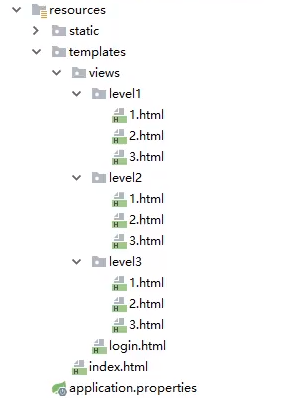Spring Security是一个功能强大且高度可定制的身份验证和访问控制框架。它实际上是保护基于spring的应用程序的标准。
认证,授权(vip1,vip2,vip3)
功能权限
访问权限
快速入手
新建SpringBoot项目,web模块,thymeleaf模块
导入静态资源

编写Controller
@Controller
public class RouterController {
//进首页
@RequestMapping({"/","/index"})
public String index(){
return "index";
}
//登录页面
@RequestMapping("/toLogin")
public String toLogin(){
return "views/login";
}
//VIP1才能进入的页面,传ID
@RequestMapping("/level1/{id}")
public String level1(@PathVariable("id") int id){
return "views/level1/"+id;
}
//VIP2才能进入的页面,传ID
@RequestMapping("/level2/{id}")
public String level2(@PathVariable("id") int id){
return "views/level2/"+id;
}
//VIP3才能进入的页面,传ID
@RequestMapping("/level3/{id}")
public String level3(@PathVariable("id") int id){
return "views/level3/"+id;
}
}
现在的页面

要做成有些页面某些人访问不了。
登录之后每个人看到的不一样,某些东西不能展示。
几个重要的类
- WebSecurityConfigurerAdapter:自定义Security策略,适配器模式
- AuthenticationManagerBuilder:自定义认证策略,建造者模式。
- @EnableWebSecurity:开启WebSecurity模式
使用
1:引入SpringSecurity模块
<dependency>
<groupId>org.springframework.boot</groupId>
<artifactId>spring-boot-starter-security</artifactId>
</dependency>
2:编写SpringSecurity配置类
@EnableWebSecurity // 开启WebSecurity模式
//必须继承WebSecurityConfigurerAdapter
public class SecurityConfig extends WebSecurityConfigurerAdapter {
//根据自己需求重写configure方法,定义授权规则
@Override
protected void configure(HttpSecurity http) throws Exception {
// 定制请求的授权规则
// 首页所有人可以访问
http.authorizeRequests().antMatchers("/").permitAll()
.antMatchers("/level1/**").hasRole("vip1")
.antMatchers("/level2/**").hasRole("vip2")
.antMatchers("/level3/**").hasRole("vip3");
//没有权限跳转到登录页面,需要开启登录
http.formaLogin();
//开启注销功能.前端请求为 /logout,默认注销完成调到登录,指定跳到首页
http.logout().logoutSuccessUrl("/");
}
//定义认证规则
@Override
protected void configure(AuthenticationManagerBuilder auth) throws Exception {
//在内存中定义,也可以在jdbc中去拿....
//Spring security 5.0中新增了多种加密方式,也改变了密码的格式。
//要想我们的项目还能够正常登陆,需要修改一下configure中的代码。我们要将前端传过来的密码进行某种方式加密
//spring security 官方推荐的是使用bcrypt加密方式。
auth.inMemoryAuthentication().passwordEncoder(new BCryptPasswordEncoder())
.withUser("kuangshen").password(new BCryptPasswordEncoder().encode("123456")).roles("vip2","vip3")
.and()
.withUser("root").password(new BCryptPasswordEncoder().encode("123456")).roles("vip1","vip2","vip3")
.and()
.withUser("guest").password(new BCryptPasswordEncoder().encode("123456")).roles("vip1","vip2");
}
//实际项目中的认证
@Autowired
private UserDetailsService userDetailsService;
@Autowired
public void configureAuthentication(AuthenticationManagerBuilder authenticationManagerBuilder) throws Exception {
authenticationManagerBuilder
// 设置UserDetailsService
.userDetailsService(this.userDetailsService)
// 使用BCrypt进行密码的hash
.passwordEncoder(passwordEncoder());
//remember me
//默认保留14天
authenticationManagerBuilder.eraseCredentials(false);
}
}
新需求,如果用户没有登录的时候,导航栏上只显示登录按钮,用户登录之后,导航栏可以显示登录的用户信息及注销按钮!还有就是,比如kuangshen这个用户,它只有 vip2,vip3功能,那么登录则只显示这两个功能,而vip1的功能菜单不显示!这个就是真实的网站情况了!该如何做呢?
我们需要结合thymeleaf中的一些功能
sec:authorize="isAuthenticated()":是否认证登录!来显示不同的页面。
1:导入依赖
<!-- https://mvnrepository.com/artifact/org.thymeleaf.extras/thymeleaf-extras-springsecurity4 -->
<dependency>
<groupId>org.thymeleaf.extras</groupId>
<artifactId>thymeleaf-extras-springsecurity5</artifactId>
<version>3.0.4.RELEASE</version>
</dependency>
2:修改前端页面
导入命名空间
xmlns:sec="http://www.thymeleaf.org/thymeleaf-extras-springsecurity5"
修改导航栏,增加认证判断
<!--登录注销-->
<div class="right menu">
<!--如果未登录-->
<div sec:authorize="!isAuthenticated()">
<a class="item" th:href="@{/login}">
<i class="address card icon"></i> 登录
</a>
</div>
<!--如果已登录-->
<div sec:authorize="isAuthenticated()">
<a class="item">
<i class="address card icon"></i>
用户名:<span sec:authentication="principal.username"></span>
角色:<span sec:authentication="principal.authorities"></span>
</a>
</div>
<div sec:authorize="isAuthenticated()">
<a class="item" th:href="@{/logout}">
<i class="address card icon"></i> 注销
</a>
</div>
</div>
版本问题可能会导致一些问题
配置登录页面
http.formLogin().loginPage(“toLogin”);
过滤器
过滤器链加载:
我们在web.xml中配置了一个名称为springSecurityFilterChain的过滤器DelegatingFilterProxy,DelegatingFilterProxy通过springSecurityFilterChain这个名称,得到了一个FilterChainProxy过滤器,然后调用常见的15个过滤器
SecurityContextPersistenceFilter
首当其冲的一个过滤器,作用之重要,自不必多言。
SecurityContextPersistenceFilter主要是使用SecurityContextRepository在session中保存或更新一SecurityContext,并将SecurityContext给以后的过滤器使用,来为后续filter建立所需的上下文。SecurityContext中存储了当前用户的认证以及权限信息。
WebAsyncManagerIntegrationFilter
此过滤器用于集成SecurityContext到Spring异步执行机制中的WebAsyncManager
HeaderWriterFilter
向请求的Header中添加相应的信息,可在http标签内部使用security:headers来控制(仅限于JSP页面)
CsrfFilter
csrf又称跨域请求伪造,SpringSecurity会对所有post请求验证是否包含系统生成的csrf的token信息, 如果不包含,则报错。起到防止csrf攻击的效果。
LogoutFilter
匹配URL为/logout的请求,实现用户退出,清除认证信息。
UsernamePasswordAuthenticationFilter
认证操作全靠这个过滤器,默认匹配URL为/login且必须为POST请求。
DefaultLoginPageGeneratingFilter
如果没有在配置文件中指定认证页面,则由该过滤器生成一个默认认证页面。
DefaultLogoutPageGeneratingFilter
由此过滤器可以生产一个默认的退出登录页面
BasicAuthenticationFilter
此过滤器会自动解析HTTP请求中头部名字为Authentication,且以Basic开头的头信息。
RequestCacheAwareFilter
通过HttpSessionRequestCache内部维护了一个RequestCache,用于缓存HttpServletRequest
SecurityContextHolderAwareRequestFilter
针对ServletRequest进行了一次包装,使得request具有更加丰富的API
AnonymousAuthenticationFilter
当SecurityContextHolder中认证信息为空,则会创建一个匿名用户存入到SecurityContextHolder中。 spring security为了兼容未登录的访问,也走了一套认证流程,只不过是一个匿名的身份。
当用户以游客身份登录的时候,也就是可以通过设置某些接口可以匿名访问
SessionManagementFilter
SecurityContextRepository限制同一用户开启多个会话的数量
ExceptionTranslationFilter
异常转换过滤器位于整个springSecurityFilterChain的后方,用来转换整个链路中出现的异常
FilterSecurityInterceptor
获取所配置资源访问的授权信息,根据SecurityContextHolder中存储的用户信息来决定其是否有权 限
该过滤器限制哪些资源可以访问,哪些不能够访问